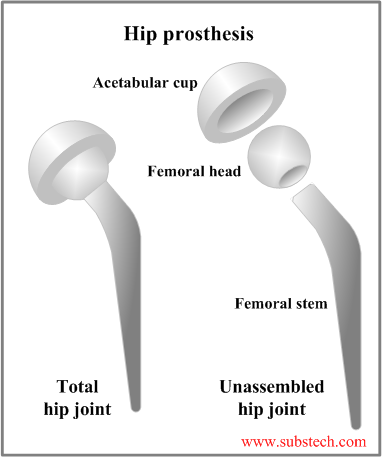to Ceramics
to Applications of ceramics
Materials for joint prostheses
Dr. Dmitri Kopeliovich
Implanting joint prostheses has been successfully used in the therapeutic practice since 1950s.
Metals and polymers for joint prostheses
 Metals were the first type of materials used for joint prostheses.
Metals were the first type of materials used for joint prostheses.
The following alloys are used for that application:
- Cobalt-chromium-molybdenum alloys (e.g., 62.2% Co, 28.7% Cr, 6.3% Mo, 0.87% Si, 0.71% Ni, 0.59% Mn, 0.53% Fe, C 0.057%)
Cobalt-chromium-molybdenum alloys are most common metallic materials used in joint replacement.
Properties of the alloys have been considerably improved for the last decades. Homogeneous micro-structure (fine Grain structure and uniform distribution of carbides) has been achieved.
Benefits of cobalt-chromium alloys:
- Good corrosion resistance as compared to other metallic materials;
- High toughness in comparison to ceramics;
- Wear resistance higher than in other metallic materials and polymers;
- Higher hardness (HV = 350) and strength as compared to other metallic materials and polymers;
Metals in the joint prostheses are used in form of either metal-on-metal bearings or metal-on-polyethylene bearings (metallic femoral head and polyethylen acetabular cup).
The application of the metal-on-metal bearing is limited due the dissolution of toxic metal ions (cobalt, chromium) in the regions surrounding the joint from the metallic debris. The debris are the result of the wear between the two metallic parts of the bearing.
Metal-on-polyethylene bearings do not produce metallic debris however the wear of the polyethylene part is relatively high. Use of polyethylene with increased cross-linking allows to reduce its wear and toughness.
to top
Alumina ceramic for joint prostheses
Ceramics have been extensively used for hip replacement (total hip arthroplasty) and much rarer for knee replacement.
Replacement of the femoral head material in a metal-on-polyethylene bearing from metal to alumina resulted in a reduction of polyethylene wear. However osteolysis caused by polyethylene debris generated by alumina-on-polyethylene prostheses was not prevented.
Alumina-on-alumina joint prostheses allowed to eliminate both metal and polyethylene debris formation.
The new generation alumina ceramics are manufactured by Hot Isostatic Pressing (HIP). They have high density (248.4 lb/ft3 / 3.98 g/cm3), high purity and fine grains (70 μinch / 1.8 μm).
Fine Grain structure of alumina allows to achieve very low surface roughness after polishing (less than 0.05 μm Ra), which determines extremely low wear rate and low coefficient of friction.
Wear rate and coefficient of friction of different joint prosthesis materials
| Materials | Wear rate | Coefficient of friction | |
|---|---|---|---|
| mm/year | mil/year | ||
| Metal-on-polyethylene | 0.25 | 10 | 0.07 |
| Metal-on-Metal | 0.025 | 1 | 0.25 |
| Alumina-on-polyethylene | 0.075 | 3 | 0.002-0.07 |
| Alumina-on-alumina | 0.0025 | 0.1 | 0.002-0.07 |
Benefits of alumina-on-alumina hip prostheses:
- Low wear rate;
- High hardness (HV = 2200);
- High scratch resistance (low three body abrasive wear);
- Low coefficient of friction;
- Excellent surface finish;
- No ion dissolution;
- High strength
- High Fatigue strength;
- Good wetting by the synovial fluid;
- Biocompatibility.
The main disadvantage of alumina as a material for hip prostheses is its low fracture toughness and strength.
The fracture toughness and 4-point flexural strength of alumina were considerably improved due to high density, fine grain structure and use of Hot Isostatic Pressing.
4-point bending flexural strength of the new generation alumina has reached 91.4 ksi / 630 MPa).
Further improvement of the fracture toughness and flexure strength was made in alumina with additions of 17-20 vol.% of zirconia (ZrO2) and some other oxides (e.g., chromium oxide).
Zirconia toughened alumina (ZTA) has flexural strength 160 ksi (1100 MPa).
However alumina is still less suitable material for the artificial hips experiencing frequent impacts.
Another disadvantage of alumina-on-alumina hip prostheses is an audible “squeaking” of hip experienced by some patients during normal motion.
Zirconia ceramic for joint prostheses
Zirconia ceramics has been used in orthopedic applications since 1985. Polycrystalline tetragonal zirconia possesses high fracture toughness and flexural strength due to its dense and fine Grain structure.
However pure tetragonal zirconia is metastable. Under an influence of temperature and mechanical stress tetragonal zirconia may transform to the monoclinic form.
The allotropic transformation causes internal stresses due to the volume changes. Such stresses decrease the toughness and strength of the ceramic.
In order to depress possible allotropic transformation of tetragonal zirconia it is doped with yiiria (about 5.15%). Yttria stabilized tetragonal phase polycrystalline zirconia (Y-TZP) was used as a material for the ceramic joint implants until 2001 when a sufficient degradation of prostheses properties (toughness, wear rate) was found. Large number of the joints fractures was reported.
Use of zirconia for hip prostheses has ceased.
to top